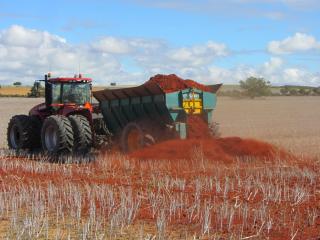The benefits of applying clay to paddocks to boost soil quality and subsequent yields are being evaluated by a new research project.
The Department of Agriculture and Food recently commenced a clay spreading trial in the West and Central Midlands and a clay delving trial near Esperance, as part of the Grains Research and Development Corporation’s ongoing Soil Water Repellence project.
Department research officer Giacomo Betti said that while the advantages of claying were widely accepted, the research would refine the understanding of claying and its relationship to other soil constraints.
Mr Betti said the research would also examine application rates and different methods of spreading and incorporating clay to optimise plant growth.
“One of the farmers we are working with uses a heavy duty multi-spreader, which can evenly spread the clay-rich subsoil over a seven metre width, which is then incorporated into the soil profile using different implements, such as spaders, offset discs and one-way ploughs,” he said.
“It will be interesting to see if this method provides additional soil nutrition to the plant roots as well as improving crop establishment.”
Subsoil with a clay content of 30 to 50 per cent is being excavated from participating farmers’ own paddocks to be laid on large scale plots in sandy and sandy gravel paddocks.
The yield response to different rates of clay is also being assessed, including 50, 100, 150, and 250 tonnes per hectare.
Mr Betti said the researchers were particularly interested in the yield response to lower rates of clay when other soil constraints were removed.
“Water repellent sandy and gravelly soils are often associated with other soil constraints, such as soil acidity and compaction,” he said.
“In an attempt to minimise the influence of compaction on the claying benefits, the plots have undergone deep ripping to facilitate root growth and plant establishment.
“As a result, we hope to demonstrate the optimum value of claying.”
The research will evaluate crop establishment, yield and nutrition uptake, alongside an economic analysis.
“Claying can be a significant investment for growers, however, it is a one-off, long term cost that has shown to reap benefits for more than a decade,” he said.
“It will be useful to develop some figures on this investment and its true value to growers’ long-term paddock production.”
Mr Betti said while the plots were sown to continuous cropping wheat paddocks, the economic analysis would also consider the possible benefits of claying to subsequent pastures in mixed farming systems.
“One of the advantages of claying is that it stabilises the soil and reduces the risk of wind erosion,” he said.
“This could create an opportunity for growers to allow their stock to graze stubbles and pastures longer and more efficiently – something this research aims to evaluate.”
Department officers will work closely with the West Midlands Group and the South East Premium Wheat Growers Association on the research, the results of which will be shared more broadly.
For more information about the department’s soil repellence work visit agric.wa.gov.au.

Media contacts: Jodie Thomson/Megan Broad, media liaison +61 (0)8 9368 3937
